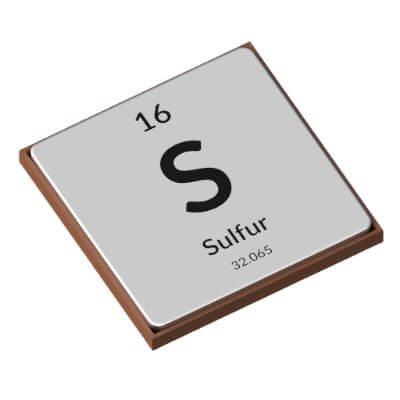
- Name: Sulfur
- Symbol: S
- Atomic Number: 16
- Atomic Weight: 32.065 u
- Period: 3
- Group: 16
25 Sulfur Facts for Kids
- Sulfur is a chemical element on the periodic table.
- Sulfur was first identified as a chemical element in 1777 by French chemist Antoine Lavoisier.
- Pure sulfur is a nonmetal that is soft, odorless and has a bright yellow color.
- Sulfur is a solid at room temperature.
- The symbol for sulfur is S.
- The atomic number for sulfur is 16.
- The standard atomic weight for sulfur is 32.065 u.
- Sulfur is in the reactive nonmetal element category on the periodic table.
- Sulfur is a period 3 chemical element, which is the third row on the periodic table.
- Sulfur is a group 16 chemical element, which is the oxygen group.
- Sulfur has four stable isotopes
- The four stable sulfur isotopes are 32S, 33S, 34S and 36S.
- The melting point for sulfur is 239.38 °F (115.21 °C).
- The boiling point for sulfur is 832.3 °F (444.6 °C).
- Sulfur is the tenth most abundant element in the universe.
- Sulfur is the fifth most abundant element in the Earth’s crust.
- Sulfur is one of the essential components of all living things.
- Sulfur can sometimes be found in its native form on Earth but is mostly found in sulfate and sulfide minerals.
- Most of the sulfur produced today is recovered as a byproduct from processing oil, natural gas and metal smelting.
- In the human body, sulfur is the 7th to 8th most abundant element by weight.
- Octasulfur (S8) is used in pharmaceutical skin products to treat acne and other skin diseases.
- Sulfuric acid (H2SO4) is used in batteries, fertilizers and to process water.
- Hydrogen sulfide (H2S) is a colorless gas that has an odor like the smell of rotten eggs.
- Sulfur dioxide (SO2) is a toxic gas that is created by mixing oxygen and sulfur together.
- Pure sulfur can be used as a pesticide or fungicide.
Additional Resources on Sulfur
- Sulfur (s) – Learn more about the chemical element sulfur on the Los Alamos National Laboratory website.
- The Element Sulfur – Discover more cool facts about sulfur on the Jefferson Labs website.
- Sulfur – RSC – Find more awesome facts about sulfur on the Royal Society of Chemistry website.
- Sulfur – Britannica – Read more about sulfur and its properties on the Britannica website.
